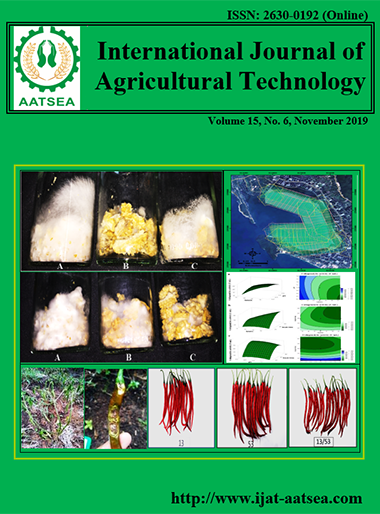Influences of trinexapac-ethyl on development and sugar content of sorghum bicolor
Main Article Content
Abstract
Result showed that no-interactions among the cultivars. The different trinexapac-ethyl doses and different periods of pre-harvest weeks provided significantly different sweet sorghum growth and yield at the p < 0.05. The control treatment provided the highest growth but low sugar yield. The trinexapac-ethyl ripener affected the highest growth and sugar yield when applied at 0.05 ppm and 1 pre-harvest week. On the other hand, trinexapac-ethyl (0.20 ppm) level inhibited the growth of sweet sorghum when applied at 5 pre-harvest weeks. At 0.05 ppm dose and 1 pre-harvest week, the chemical ripener provided the tallest plant height, biggest stalk diameter, juice extract, and sugar yields. Based on these findings, we recommended to apply the trinexapac-ethyl at 0.05 ppm dose by spraying 1 week before harvest. The sweet sorghum variety is recommended to be KKU 40 cultivar.
Article Details

This work is licensed under a Creative Commons Attribution-NonCommercial-NoDerivatives 4.0 International License.
References
Adams, R., Weiler, E. W., Kerber, E., Pfister, K. and Schar, H. P. (1991). Studies on the action of the new growth retardant CGA 163’935. Proceedings of the 14th International Conference on Plant Growth Substances, Amsterdam, pp.818-827.
Adams, R., Kerber, E., Pfister, K. and Weiler, E. W. (1992). Studies on the action of the new growth retardant CGA 163’935 (Cimectacarb). Progress in plant growth regulation: proceedings of the 14th International Conference on Plant Growth Substances, Amsterdam, Netherlands, pp.818-827.
Almodares, A. and Hadi, M. R. (2009). Production of bioethanol from sweet sorghum: A review. African Journal of Agricultural Research, 4:772-780.
Almodares, A. and Hoseini, S. H. (2016). Effect of sowing dates and nitrogen levels for ethanol production from sweet sorghum stalks and grains. African Journal of Agricultural Research, 11:266-275.
Correia, M. M. and Leite, G. J. (2012). Selectivity of the plant growth regulators trinexapac-ethyl and sulfometuron-methyl to cultivated species. Scientia Agricola, 69:194-200.
Czeluściński, W., Jankowski, K., Sosnowski, J. and Malinowska, E. (2017). Effects of trinexapac-ethyl on turfgrass growth and frequency of mowing Applied Ecology and Environmental Research, 15:739-746.
Dalley, C. D. and Richard, E. P. (2010). Herbicides as ripeners for sugarcane. Weed Science, 58:329-333.
Dar, R. A., Dar, E. A., Kaura, A. and Phutela, U. G. (2018). Sweet sorghum-a promising alternative feedstock for biofuel production. Renewable and Sustainable Energy Reviews, 82:4070-4090.
Faria, A. T., Silva, A. F., Ferreira, E. A., Rocha, P. R. R., Silva, D. V., Silva, A. A. and Tironi, S. P. (2014). Changes in physiological characteristics of sugarcane caused by trinexapac-ethyl. Revista Brasileira de Ciências Agrárias, 9:200-204.
Kingston, G. and Rixon, C. M. (2007). Ripening response of twelve sugarcane cultivars to Moddus® (trinexapac-ethyl). 8th Australian Society of Sugar Cane Technologists (ASSCT) Proceedings, Cairns, Queensland, Australian, 328-338.
Liua, R., Lib, J. and Shena, F. (2008). Refining bioethanol from stalk juice of sweet sorghum by immobilized yeast fermentation. Renewable energy, 33:1130-1135.
Mathur, S., Umakanth, A. V., Tonapi, V. A., Sharma, R. and Sharma, M. K. (2017). Sweet Sorghum as Biofuel Feedstock: Recent Advances and Available Resources. Biotechnology for Biofuels, 10:146.
Matysiak, K. (2006). Influence of trinexapac-ethyl on growth and development of winter wheat. Journal of Plant Protection Research, 46:133-143.
Orgeron, A. J., Griffin, J. L., Legendre, B. L. and Gravois, K. A. (2013). Influence of nitrogen fertilization on sugarcane response to the ripeners glyphosate and trinexapac-ethyl. Journal of the American Society of Sugar Cane Technologists, 33:30-37.
Palumbo, A. D., Vonella, A. V., Garofalo, P., Andrea, L. D. and Rinaldi, M. (2014). Response of a two-year sugar beet-sweet sorghum rotation to an agronomic management approach diversified by soil tillage and nitrogen fertilisation. Italian Journal of Agronomy, 9:109-114.
Rademacher, W. (2000). Growth retardants: effects on gibberellin biosynthesis and other metabolic pathways. Annual Review of Plant Physiology and Plant Molecular Biology, 51:501-531.
Rao, S. S., Patil, J. V., Prasad, P. V. V., Reddy, D. C. S., Mishra, J. S., Umakanth, A. V., Reddy, B. V. S. and Kumar, A. A. (2013). Sweet sorghum planting effects on stalk yield and sugar quality in semi-arid tropical environment. Agronomy Journal, 105:1458-1465.
Regassa, T. H. and Wortmann, C. S. (2014). Sweet sorghum as a bioenergy crop: Literature review Biomass and Bioenergy, 64:348-355.
Resende, P. A. P., Soares, J. E. and Hudetz, M. (2000). Moddus, a plant growth regulator and management tool for sugarcane in Brazil. Sugar Cane International, 4:5-9.
Shukla, S., Felderhoff, T. J., Saballos, A. and Vermerrisab, W. (2017). The relationship between plant height and sugar accumulation in the stems of sweet sorghum (Sorghum bicolor (L.) Moench). Field Crops Research, 203:181-191.
Spaunhorst, D. J., Todd, J. R. and Hale, A. L. (2019). Sugarcane cultivar response to glyphosate and trinexapac-ethyl ripeners in Louisiana. PLoS ONE, 14: e0218656.
Tew, T. L. and Cobill. R. (2006). Evaluation of sweet sorghum as a complementary bioenergy crop to sugarcane in Louisiana. Journal of American Society of Sugar Cane Technologists, 26:57-58.
Tsuchihashi, N. and Goto, Y. (2004). Cultivation of sweet Sorghum (Sorghum bicolor (L.) Moench) and determination of its harvest time to make use as the raw material for fermentation practiced during rainy season in dry land of Indonesia. Plant Production Science, 7:442-448.
Van Heerden, P. D. R. (2014). Evaluation of trinexapac-ethyl (Moddus) as a new chemical ripener for the South African sugarcane industry. Sugar Technol, 16:295-299.
Van Heerden, P. D. R., Mbath, T. P. and Ngxaliwea, S. (2015). Chemical ripening of sugarcane with trinexapac-ethyl (Moddus®) - Mode of action and comparative efficacy. Field Crops Research, 181:69-75.
Vannavong, W. and Detpiratmongkol, S. (2008). Effect of irrigation frequencies and water amounts on growth and yield of sweet sorghum. Proceedings of the 46th Kasetsart University Annual Conference, Subject: Plants, Kasetsart University, Bangkok, Thailand, pp.481-488.
Yanaso, P. and Detpiratmongkol, S. (2009). Effect of water deficit on growth and yield of sweet sorghum. Proceedings of the 47th Kasetsart University Annual Conference, Subject: Plants, Kasetsart University, Bangkok, Thailand, pp.465-472.


